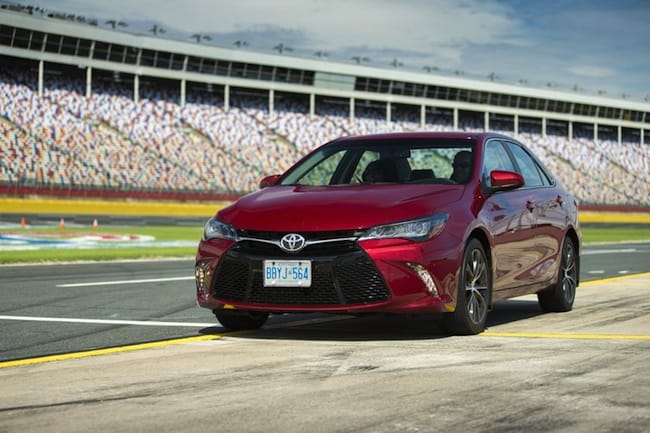Charlotte, NC – Completely rebuilt and only three years since its last major update, the all-new 2015 Toyota Camry is tenaciously shedding its conservative image. But for a sedan that historically equates to beige and bland more than energetic and fun, can North America’s best-selling passenger car attract the younger buyer and stave off the hot mid-size sedan competition while maintaining its market dominance? A progressive new design and 210 km/hr on the Charlotte Motor Speedway (yes, in a Camry) indicates yes.

Automakers work hard building their brands, encouraging us to buy into their message, and ultimately, to drive away in their product. But later reforming those same perceptions to attract a different consumer is perhaps the greater challenge.
Today, it appears the dependability and value mantra alone is no longer enough, particularly in the typically uninspiring family sedan segment, where consumers are now demanding more flair and personality—from bolder, sportier design and premium interior standards to increased emphasis on driving dynamics and better overall performance.

The market has spoken, and car companies are beginning to respond. Coupled with a new crop of more daring, redesigned sedans, including the all-new Subaru Legacy, Ford Fusion, and Honda Accord hot on the Camry’s heels, Toyota’s quick decision to reposition their flagship vehicle is probably a good one. And frankly, it appears they’re on the right track — taking what works and simply improving it.
More recently, Toyota’s first-ever TRD-spec 2020 Camry joined the lineup, sporting sleek looks and a 301-hp V6.
Whether the new 2015 Toyota Camry is now targeting a more youthful market or simply catering to its current value-conscious sedan buyer with a sportier, bolder offering, the fact remains: the new Camry is world’s apart from the outgoing model, in almost every way. And that’s a very good thing.
New Camry XSE V6 Sports Model and Hybrid SE Lead the Charge
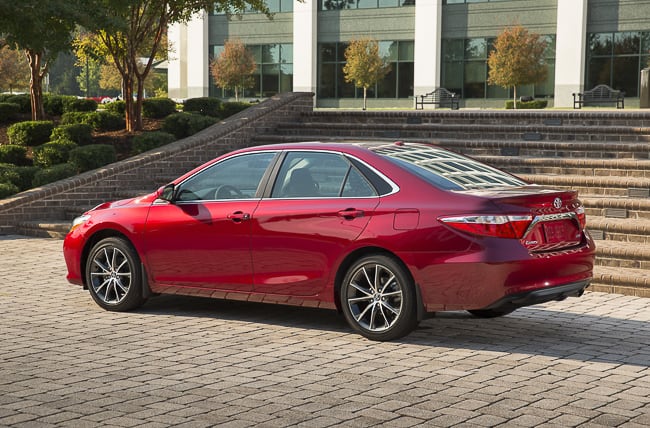
Available in nine models, including three hybrid versions, the Camry’s resurgence is led by the addition of the new top-tier, sportier XSE model, starting at $27,990 MSRP; followed by the Camry XSE-B starting at $29,890, with a blind-spot monitoring system, garage door opener, a power moonroof, and an electro-chromatic rear view mirror with integrated compass; and finally, the Camry XSE 3.5-litre V6 with 6-speed automatic transmission starting at $33,650, adding premium navigation, 10-speaker JBL audio, the blind spot monitor, rear cross traffic alert, and sleeker LED headlamps.
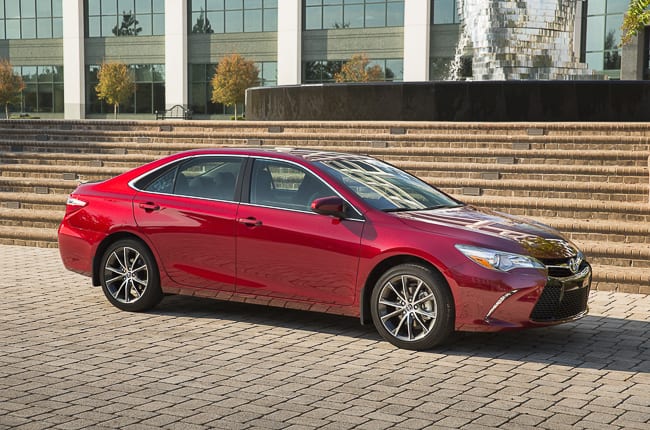
Essentially, the new XSE takes the current SE model to the next level with added luxury and driving dynamics, distinguished by a mesh grille and reworked fascia treatment, coupled with distinct shock absorbers, firmer bushings, higher rate coil springs, livelier EPS tuning, and XSE-specific 18-inch wheels.
In addition to the XSE, Toyota is offering a Hybrid SE model for 2015, combining ultimate fuel-efficiency with entirely new on-road capability with a huge boost in handling, from a new and retuned stability control system for a smoother drive to enhanced steering and a firmer stabilizer bar.
The Camry Hybrid SE starts at $29,635; the Camry Hybrid LE and Hybrid XLE start at $28,410 and $34,500 respectively.
Styling: Expressive New Design and Reworked Lighting
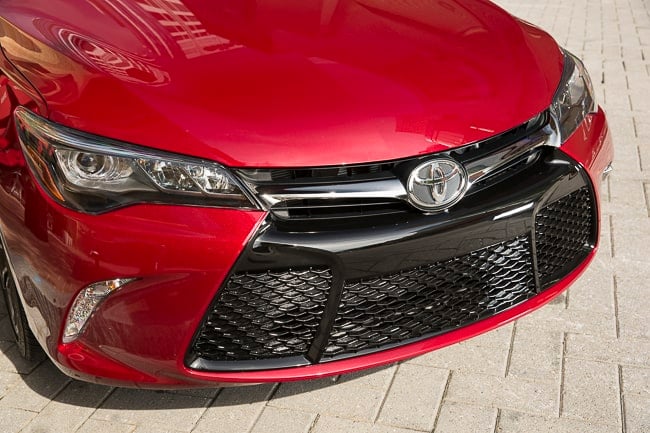
Forget everything you’ve known about Camry styling. Seriously. The new 2015 Toyota Camry is antithetical to the outgoing 2014 model. With nearly 2000 new parts, Toyota stripped the Camry to the chassis and rebuilt everything except the roof, producing a sedan with a premium, athletic look and a wider stance.
The previous rendition of the Camry was truly ambiguous — with a boxy rear end and a somewhat curvier front end treatment, nothing about the sedan really flowed nor did it seem to follow any design strategy. Simply, a best-selling vehicle with a lost identity. And what that says about the conventional Camry owner, I don’t know.
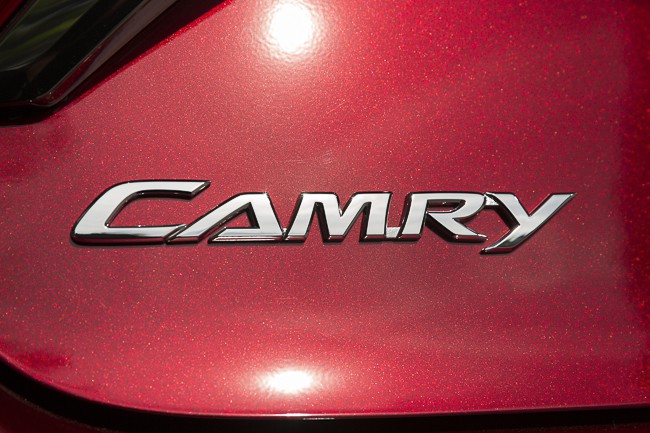
Fortunately, the all-new version truly is bold: now with a sleeker, more refined front-end structure, stronger character lines running front-to-back, and a much more streamlined rear end, the new Camry’s overall length extends an extra 45mm while the front/rear treads get a 10mm boost. Plus, there are five new vibrant colours to choose from (nine in total).
The new 2015 Camry’s exterior lighting has also been completely reworked. The fog light cover is gone, and the front signal lamp is now integrated into the bumper. The halogens are a new design, while LEDs now add a much-needed dose of style and performance.
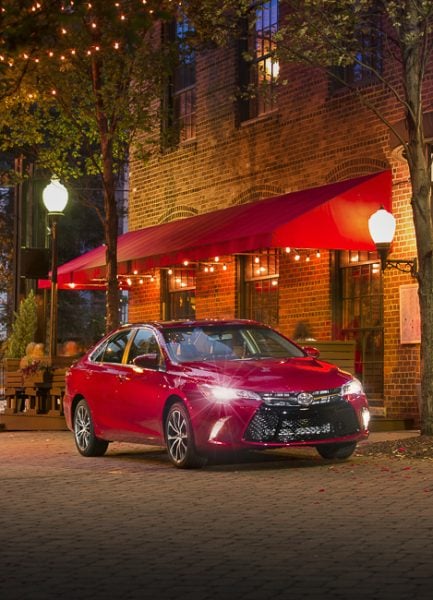
The sportier XSE and SE receive dark headlamps, while the XLE and XSE find LED daylight running lights with five LEDs per lamp and replace the old fog lights. All V6-equipped Camry’s find LED headlamps. At the back, the rear wraparound style combination lamps look both contemporary and clean without overdoing it.
2015 Toyota Camry Interior: No More Outdated Cabin

Inside, the focus was on the centre stack, now with larger buttons, new knobs, and the clock moved to the screen. The doors receive a high-point appearance and it’s clear Toyota really worked on the overall contours of the cabin. Basically, the older Camry cabin was severely outdated, and these new changes couldn’t have come any sooner, now with upscale interior features and premium, soft-touch materials.
For instance, by removing the large, useless dummy covers nestled among the console switches and doing away with the standalone digital clock sitting high above the stack, the updated Camry interior is now certainly on par with the competitor’s upscale offering.

While the use of hard switches, knobs, and dials is welcomed (as opposed to the touchy, feely, swipe touch-screen controls found in many vehicles today), and the overall centre stack layout is logical and convenient, the buttons flanking the screen are absolutely enormous, almost unnecessarily.
But hey, it all looks ten times better than before, stepping away from the bland and into the now. Also new is the front box, at the bottom of the centre stack, now with visibility of the USB ports and 12V outputs, plus a segment-first available wireless charging system for select smartphones. The instrument panel features a new 4.2-inch TFT screen nestled between the three-dimensional Optitron gauges on the SE, XLE, and XSE models.
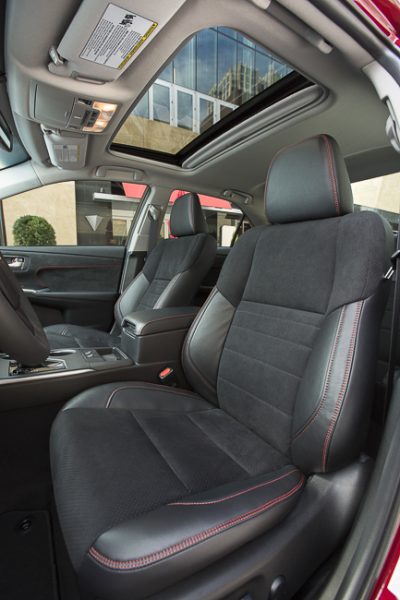
Other cabin changes include a new front door trim with larger soft ornament and French stitching, as opposed to the decorative top stitch in the previous version. The new front door style is also less dated than before, with black metallic finish, satin chrome, and sophisticated flow into the pull cup.

A new trunk hinge cover offers a cleaner look; the floor carpet dampens any floor panel vibration; a heavy backing layer and door service hole inserts help block noise. In fact, this all-new Camry boasts the quietest cabin yet (the chassis and body structure are bolstered with additional spot welds).
Driving Dynamics: how does the 2015 Camry XSE perform?
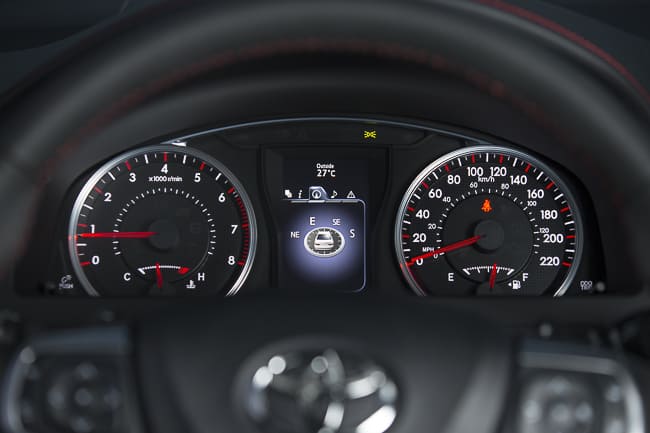
We had the opportunity to rip around the legendary Charlotte Motor Speedway with NASCAR driver Kenny Wallace, hitting speeds in excess of 200-km/hr — yes, in a factory 2015 Toyota Camry XSE trim. Coupled with slalom exercises. Conclusions drawn? The new 2015 Camry offers enhanced rigidity for a ride quality unlike anything this restrained sedan has experienced before, coupled with a re-tuned suspension and steering system takes the Camry’s handling to a completely new level of responsiveness.
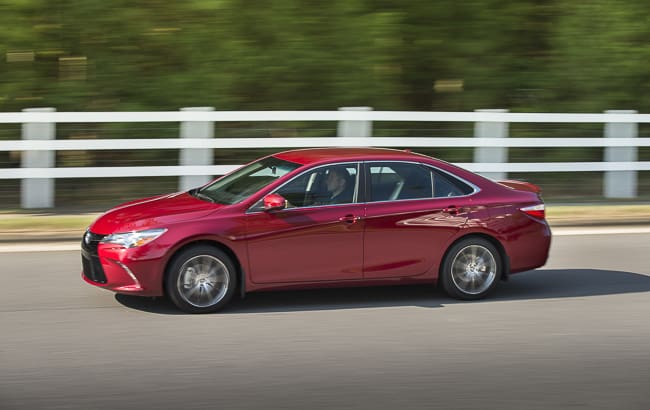
Even on the open road, our Camry XSE provided spirited yet smooth and refined handling. The new Camry benefits from additional spot welds added to the door opening flanges to increase rigidity and allow for new suspension tuning. Across all trim levels, a multi-link arrangement at the rear and a stiffer body structure allow for unique suspension tuning as well.
We had become so comfortable with the good-old, reliable, middle-of-the-road Camry sedan all these years that it was perhaps inconceivable Toyota’s buttoned-down ambassador could be anything more than adequate.
In addition to all the suspension and stability upgrades, the 2015 Toyota Camry now receives enhanced steering response, additional torque to limit rotational speed differences, and significantly improved braking dynamics.
Powered by a 4-cylinder 2.5-litre engine, the Camry produces 178-hp @ 6,000 rpm and 170 lb.ft of torque at 4,100 rpm. While the V6 Camry is powered by a 3.5-litre making 268-hp at 6,200 rpm and 248 lb.ft of torque at 4,700 rpm. The three Hybrid offerings a receive power via the 2.5-liter Atkinson Cycle engine with Hybrid Synergy drive matched to an E-CVT.
Takeaway
We had become so comfortable with the good-old, reliable, middle-of-the-road Camry sedan all these years that it was perhaps inconceivable Toyota’s buttoned-down ambassador could be anything more than adequate, filling the void for value-seeking, beige khaki-wearing consumers simply looking to get from point A-to-B as modestly as possible.
But the mid-size sedan market is changing, consumer tastes are evolving, and the competition is stepping up its game big time. Toyota realized this, acting quickly yet not hastily, reinventing its Camry sedan in a manner that makes sense: take what already works and make it better…much better. This is not done by simply redesigning exteriors and sprucing up interiors but by really investing in the performance by dialling up the driving dynamics, offering consumers something they can actually enjoy.
Or perhaps something they didn’t realize even existed: fun, spirited driving in a well-designed, affordable passenger sedan.

